Back in the BC — before coronavirus — days, Alec Gates co-ran a bike tour company. Since his customers were primarily foreign holidaymakers and recently arrived expats, business has almost completely dried up over the last year.
“That now feels like ancient history,” Gates said last weekend, when Cycling Shorts met him at his bike shop in a lane off Chongqing North Road (重慶北路) in Datong District (大同) for a spin around the capital’s historical neighborhoods.
The following is based on the tour that he used to give before the pandemic struck — one that is ideal for anyone wanting to get out on a rental or their own bike during the Lunar New Year holiday, when Taipei’s streets are largely empty of traffic.
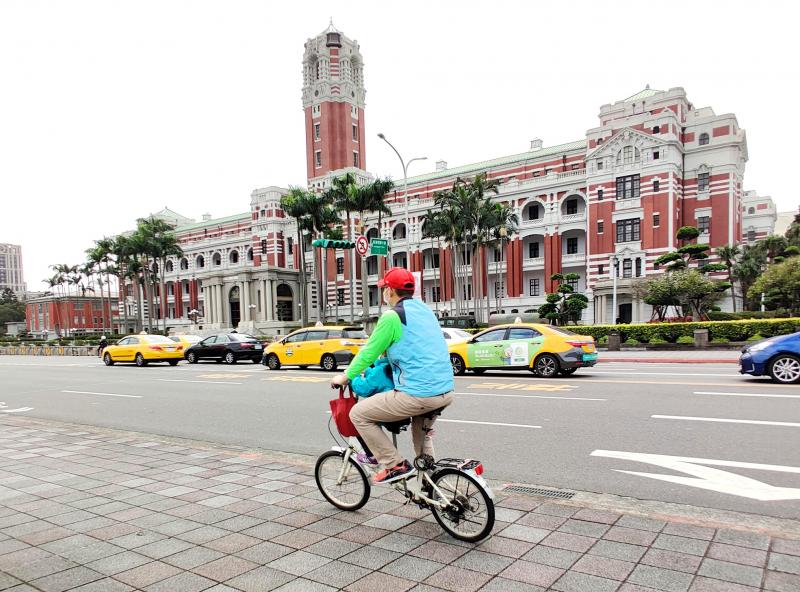
Photo: Mark Caltonhill
SEEING TAIPEI DIFFERENTLY
From Chaoyang Tea Park (朝陽茶葉公園) we head east along Mingsheng West Road (民生西路) to the Shuanglian (雙連) morning market to immerse ourselves in the sights, sounds, smells and, most importantly, tastes of Taiwan’s food culture. The market, like any that dot the capital city’s landscape, is the ideal place to nourish yourself on egg pancakes (蛋餅), rice balls (飯糰) and soymilk before embarking on this four-hour ride.
We then head further east to the Wenchang Temple (文昌宮), known as the divine protector of academics and education. Lined up along an altar are several photocopies of ID cards. The IDs belong to students who will soon take exams, and the offerings of celery (芹; qin in Mandarin) and radishes (菜頭; tsai-tao in Hoklo, also known as Taiwanese) sound like “diligence” (勤勞; qin-lao) and “good omen” (好彩頭; ho tsai-tao).
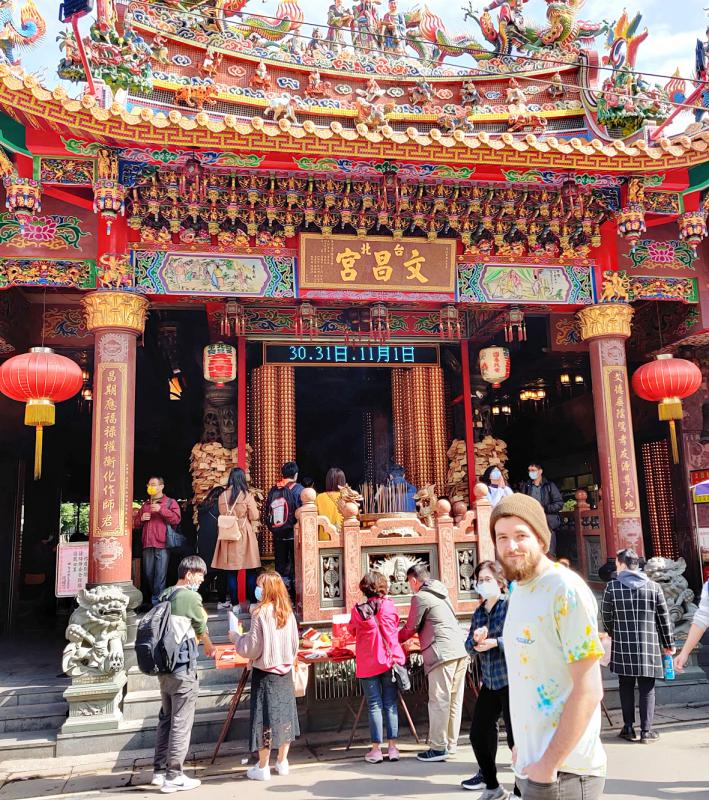
Photo: Mark Caltonhill
Heading south along Zhongshan South Road (中山南路), cyclists get a taste of Taiwan’s modern political history with stops at the Dr Sun Yat-sen Memorial House (國父史蹟館), and, 10 minutes further along the same road, National Chiang Kai-shek Memorial Hall (國立中正紀念堂). The latter has an excellent museum explaining Taiwan’s post-World War II history through images, info boards and objects culled from the reign of former president Chiang Kai-shek (蔣介石). The large complex also features sprawling grounds with ornate gardens with artificial ponds full of carp as well as the monumental National Theater and Concert Hall.
A taste of Taiwan’s earlier history can be seen at the East Gate: its Aboriginal prehistory, Dutch and Spanish settlements in the nation’s southeast and northwest respectively, Han Chinese immigration and the construction of Taipei City with its gates and old city wall, which were quickly torn down under Japanese rule (1895 to 1945).
Like the grounds where Chiang Kai-shek Memorial Hall is located, the 228 Memorial Museum (228紀念館), located less than a five-minute ride away to the northeast, features a large park with statues, pagodas and artificial lakes. It’s also a place where visitors can recall Chiang’s darkest hour on Taiwan, when officials from the Tobacco Monopoly Bureau on Feb. 28, 1947 violently confiscated contraband cigarettes from a female seller. The act sparked an uprising against the Chinese Nationalist Party (KMT), which was violently suppressed. The events led to 38 years of martial law, known as the period of White Terror (白色恐怖), in which tens of thousands of civilians were killed, imprisoned or disappeared.
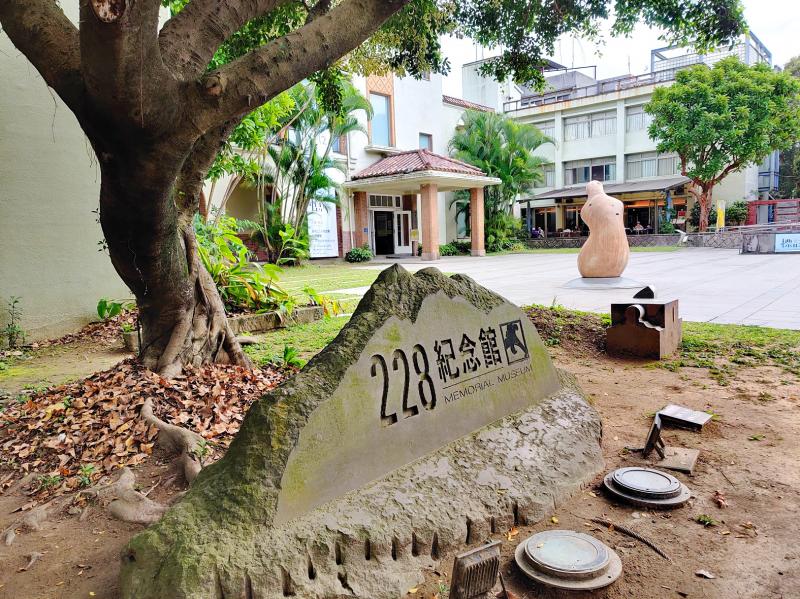
Photo: Mark Caltonhill
Biking a further five minutes west along Baoqing Road (寶慶路), the route arrives at the Ximending (西門町) shopping district, which has experienced something of a renaissance after Taipei’s center of gravity shifted eastward over recent decades.
From here, it’s five minutes along Chengdu Road (成都路) to the scenic Yanping Riverside Park (延平河濱公園), which takes you northward to Dadaocheng Wharf (大稻埕碼頭), one of the city’s oldest and most important, which facilitated domestic and international trade in the 18th and 19th centuries, making Taipei a natural location for the capital when Taiwan finally became a province of the Qing Dynasty in 1887.
A few minutes away from the wharf is the final stop, Dihua Street (迪化街), where all manner of traditional goods are still on sale in shops that have stood for more than a century, many still owned by the original families.
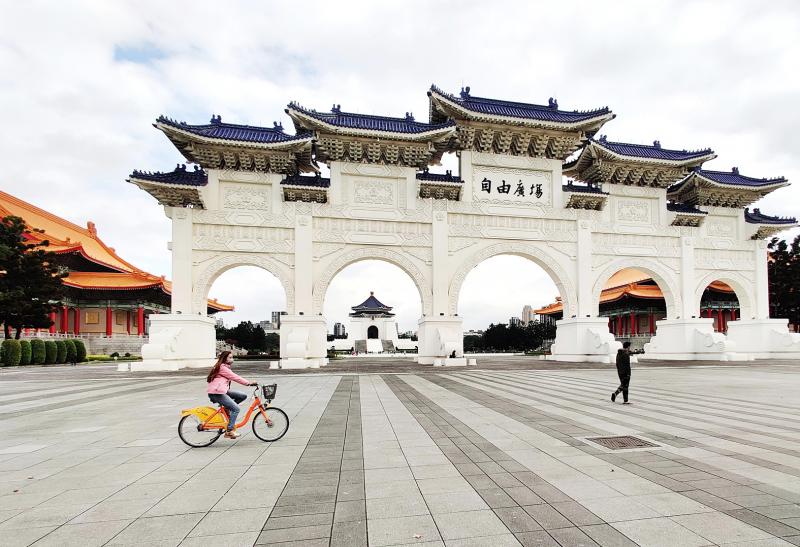
Photo: Mark Caltonhill
January and February normally see hundreds of thousands of shoppers crowding the street for the two-week Lunar New Year market but, like Gates’ bike tours, this has also been canceled this year due to the pandemic.
Mark Caltonhill bikes, and writes, and writes about bikes.

Photo: Mark Caltonhill
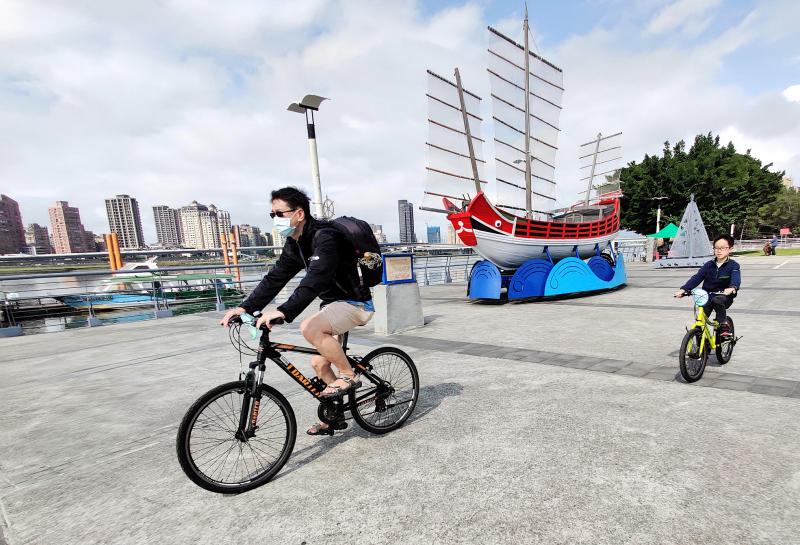
Photo: Mark Caltonhill

The Directorate-General of Budget, Accounting and Statistics (DGBAS) told legislators last week that because the Chinese Nationalist Party (KMT) and Taiwan People’s Party (TPP) are continuing to block next year’s budget from passing, the nation could lose 1.5 percent of its GDP growth next year. According to the DGBAS report, officials presented to the legislature, the 2026 budget proposal includes NT$299.2 billion in funding for new projects and funding increases for various government functions. This funding only becomes available when the legislature approves it. The DGBAS estimates that every NT$10 billion in government money not spent shaves 0.05 percent off

It is a soulful folk song, filled with feeling and history: A love-stricken young man tells God about his hopes and dreams of happiness. Generations of Uighurs, the Turkic ethnic minority in China’s Xinjiang region, have played it at parties and weddings. But today, if they download it, play it or share it online, they risk ending up in prison. Besh pede, a popular Uighur folk ballad, is among dozens of Uighur-language songs that have been deemed “problematic” by Xinjiang authorities, according to a recording of a meeting held by police and other local officials in the historic city of Kashgar in
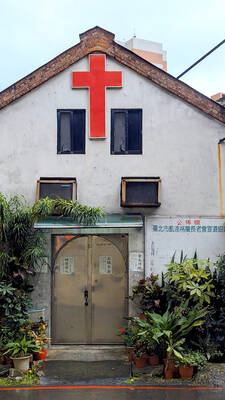
Dec. 29 to Jan. 4 Like the Taoist Baode Temple (保德宮) featured in last week’s column, there’s little at first glance to suggest that Taipei’s Independence Presbyterian Church in Xinbeitou (自立長老會新北投教會) has Indigenous roots. One hint is a small sign on the facade reading “Ketagalan Presbyterian Mission Association” — Ketagalan being an collective term for the Pingpu (plains Indigenous) groups who once inhabited much of northern Taiwan. Inside, a display on the back wall introduces the congregation’s founder Pan Shui-tu (潘水土), a member of the Pingpu settlement of Kipatauw, and provides information about the Ketagalan and their early involvement with Christianity. Most

The People’s Republic of China (PRC) was out in force in the Taiwan Strait this week, threatening Taiwan with live-fire exercises, aircraft incursions and tedious claims to ownership. The reaction to the PRC’s blockade and decapitation strike exercises offer numerous lessons, if only we are willing to be taught. Reading the commentary on PRC behavior is like reading Bible interpretation across a range of Christian denominations: the text is recast to mean what the interpreter wants it to mean. Many PRC believers contended that the drills, obviously scheduled in advance, were aimed at the recent arms offer to Taiwan by the